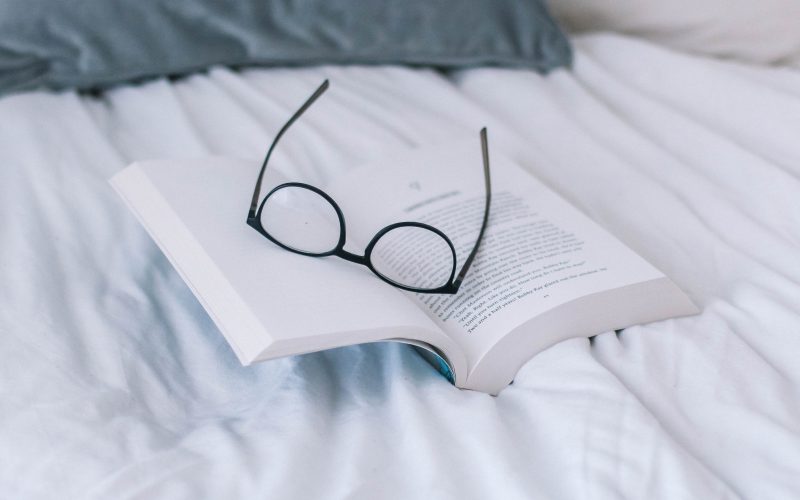Life sends subtle hints every once in a while that your vision may be fading. Maybe you’re finding yourself squinting while reading a book or struggling with fine print on a label. Perhaps you’ve felt that tired strain after scrolling through your phone for too long.
Either way, these seemingly minute changes can signify more than just fleeting moments of fatigue. They could be signs that you need reading glasses.
What are reading glasses though? Do I need reading glasses, and if so, what reading glasses do I need?
Our reading glasses guide will answer all these questions and many others you may have. We’ll walk you through how to choose reading glasses, the various reader glasses strengths, and of course, how to navigate a reading glasses test.
At Felix Gray, we aren’t just your trusted source for the best reading glasses for men and women alike. We’re here to empower you to see clearly without eye strain. So, what are reading glasses?
What Are Reading Glasses?
First up in our reading glasses guide, we need to define what this type of glasses is and how it differs from typical prescription glasses.
Definition and Purpose
Reading glasses, colloquially known as “readers”, are non-prescription lenses that enhance up-close vision. They’re designed for a singular purpose: to make reading and other close-up tasks more comfortable and clear for those who experience difficulty in doing so.
This might sound simple, but the difference they can make in daily activities – like reading, sewing, or even just browsing your smartphone – is transformative.
Our eyes naturally lose some of their elasticity as we age, which can affect our ability to focus on nearby objects. Reading glasses compensate for this decline by providing a temporary boost to our near vision.
How Do They Differ From Regular Prescription Glasses?
While reading glasses are crafted for a specific purpose, regular prescription glasses are tailored for individuals with refractive errors such as myopia (nearsightedness), hyperopia (farsightedness), or astigmatism. Here’s a breakdown of the nuanced differences between these styles:
- Prescription Level: Reading glasses come in different magnification levels, known as diopters, typically ranging from +1.00 to +4.00. These magnifications are generic and are not tailored to individual eyes. In contrast, prescription glasses have specific lens corrections based on a comprehensive eye exam by an optometrist or ophthalmologist.
- Focus Area: Reading glasses mainly enhance near vision. Prescription glasses, however, can be designed to correct vision at multiple distances, whether it’s near, far, or intermediate.
- Customization: Prescription glasses are precisely tailored for each eye based on the unique imperfections in one’s vision, ensuring balance and preventing complications. Reading glasses don’t offer this level of customization as they’re typically “off the shelf”.
- Lens Technology: Prescription lenses might incorporate advanced technology, such as progressive lenses, which provide seamless vision across multiple distances. Reading glasses are generally single-vision, focused only on close-up enhancement.
While both types of glasses aim to enhance vision, their application, customization level, and design philosophy vastly differ. This begs the question…do I need reading glasses?
Do I Need Reading Glasses?

The ability to see nearby objects clearly is something we often take for granted, but time and biology have their own plans. So, do I need reading glasses? There are a few telltale signs, but let’s first unpack the concept of Presbyopia.
The Science Behind Presbyopia (Age-Related Vision Decline)
Presbyopia is derived from the Greek words meaning “old eye”. It’s a natural part of aging that starts to occur around one’s 40th birthday. This is when the lens inside our eyes starts to lose elasticity, making it harder to focus on objects up close.
This is not due to any external factors or habits – it’s a universal experience for the vast majority. Thus, it’s not really something you can control or avoid. How does this happen, though?
Our eye’s lens is flexible and can change shape to focus on objects at varying distances. Over time, however, it becomes stiffer. So, when we try to focus on near objects, the lens doesn’t adjust as it once did, leading to blurred vision.
Common Signs You May Need Reading Glasses
Below, we’ll highlight a few indicators that suggest you may be suffering from presbyopia and need reading glasses:
- Squinting: If you find yourself squinting to read the text or see close-up items clearly, it might be an indication.
- Eye Fatigue: Experiencing tired or achy eyes after short periods of reading or detailed work.
- Holding Objects Farther Away: If you’re unconsciously moving books or devices further from your eyes to focus better, take note.
- Headaches: Frequent headaches, especially after reading or close-up tasks, could signal eye strain from uncorrected presbyopia.
- Difficulty Reading in Low Light: If reading in dimly lit environments becomes challenging, even if it wasn’t before, it’s a potential sign.
The Importance of Getting a Proper Reading Glasses Test
While off-the-shelf reading glasses might be convenient, they might not be optimal for everyone. A comprehensive eye exam can not only help you find the right readers but also confirm that you actually need them in the first place. Getting a reading glass test will empower you to:
- Determine the exact diopter strength you need, which may differ between your eyes.
- Identify other eye health concerns or vision issues.
- Provide insights into bifocal or progressive lens options, if you have trouble with both near and distant vision.
- Offer guidance on additional lens features like anti-reflective coatings or blue light filtering.
Just like you wouldn’t buy shoes without knowing your size, ensuring you have the right reading glasses strength is pivotal for comfort and optimal vision.
Moreover, regular eye exams can catch early signs of other eye conditions. Now, let’s get into the fun part of our reading glasses guide: how to choose reading glasses.
How to Choose Reading Glasses: Buying Guide to Strengths, Styles, and More

Learning how to choose reading glasses can be stressful and confusing. We’re here to eliminate that for you and leave you feeling confident and capable of choosing the right readers in this reading glasses buying guide. And remember – the perfect pair of readers is just a click away at Felix Gray!
Determining the Right Magnification for You
Reading glasses strengths are measured in diopters, which ranges typically from +1.00 to +4.00. Here’s a general guideline on which range you fall into:
- +1.00 to +2.00: Suitable for those in their 40s, or just beginning to experience difficulty with reading small print.
- +2.25 to +3.00: Often chosen by those in their mid-50s, when presbyopia tends to become more pronounced.
- +3.25 and up: Typically for individuals 60 and above.
While these guidelines offer a starting point, personal experiences may vary. It’s best to consult with an optometrist to determine the perfect strength for you.
Or, when you finish up our reading glasses buying guide, get in touch with us at Felix Gray. We have experts on standby to help you pick the right magnification along with a virtual try-on wizard!
Style Considerations: Frame Shapes, Colors, and Materials
These days reading glasses marry function with form. You can find readers that you actually enjoy wearing and that elevate your style! Here are a few key considerations:
- Frame Shapes: From classic rectangular and round shapes to acetate frames and modern geometric and cat-eye designs, the shape you choose should resonate with your personal style.
- Colors: Gone are the days when reading glasses came in just black or brown. You can find frames in vibrant colors, patterns, or even transparent designs to suit any outfit or mood.
- Materials: While plastic frames (like acetate) are lightweight and offer versatility in color and design, metal frames, including titanium, can be durable and offer a sleek, minimalist appeal.
Lens Options: Anti-glare, Tinted, and Blue Light Filtering
There are a few different features you can look for in choosing your readers. While you may not need all of them, a few stand out as particularly helpful:
- Anti-glare: These lenses reduce glare and reflections, making it easier to read in varied lighting conditions and reducing potential eye strain.
- Tinted: Lenses with a slight tint can reduce brightness and are particularly useful for readers who spend a lot of time outdoors.
- Blue Light Filtering: If you’re frequently on digital devices, these lenses can minimize blue light exposure, potentially reducing eye fatigue. We have a robust selection of blue light glasses in particular here at Felix Gray.
Understanding Your Face Shape: Which Frames Complement You?
Your unique facial shape will influence the type of frames you choose. There are even unique glasses for small faces and large faces.
Choosing the right style is nuanced, and something that may require you to try a few different styles before finding the perfect pick. But, here are a few things to keep in mind when shopping:
- Oval Face: Most frame shapes suit this versatile face shape, but rectangular frames can especially maintain its natural balance.
- Round Face: Angular or rectangular frames can provide a nice contrast, adding definition.
- Square Face: Round or oval frames can soften the angular features.
- Heart-Shaped Face: Frames that are wider at the bottom, like certain round or oval styles, can provide balance.
In essence, while the functionality of reading glasses is paramount, they also offer an opportunity to express oneself. Whether it’s the magnification strength, style, or lens options, every choice you make should be a blend of your comfort, aesthetic preferences, and eye health needs.
So, what reading glasses do I need? Let’s progress our reading glasses buying guide and discuss choosing a brand you can trust when shopping for readers, as this will eliminate any stress and uncertainty from the decision-making process.
So, What Reading Glasses Do I Need?
Choosing the right reading glasses is more than just picking a stylish frame. It’s about clarity, comfort, and trust. When you find that perfect pair, you don’t just see better – you feel better. But with so many options out there, how do you decide?
Tips on Choosing a Trusted Brand
The best way to find the right pair of reading glasses is to start by looking for a brand you can trust. This will set you up for success with a reliable, worthy guide in your journey to seeing more clearly.
Do your research into a brand’s reputation. See what sort of experiences others have had with them as you can typically expect the same yourself.
Then, look into the products themselves. Quality matters for two reasons – you want the glasses to work well, and you want them to stand the test of time. So, prioritize durable materials. You can shop with confidence if the brand stands behind its products with some sort of money-back guarantee.
Finding a brand that you feel like you can trust is harder than ever with so many options available. The good news? Your search for the perfect pair of readers ends at Felix Gray!
Why You Can Count on Felix Gray

We’re committed to elevating your well-being through reading glasses that work as hard as you do. Our glasses are the manifestation of extensive research so you can enjoy peace of mind knowing you’re getting a product that stops eye strain in its tracks.
But, we know you’re not just looking glasses that fix the issue. You want to look good in them. That’s why we’ve developed an assortment of styles to choose from. Just take a look at our readers and see which frames catch your eye (pun intended). Then, choose your magnification – getting the best readers for women and men is really that simple.
Don’t hesitate to reach out if you have any uncertainty along the way. We have virtual fit specialists on standby ready to guide you through the process.
And don’t stress about getting the wrong pair – returns and exchanges are on us, as we stand behind our products with a 30-day money-back guarantee.
Tips on Using Reading Glasses to Harness All the Power They Hold
Here are a few tips on making the most of your investment before we bring our reading glasses guide to a close.
Adjusting to Your New Reading Glasses: A Timeline
Putting on your readers for the first time will feel foreign. Expect a brief adjustment period before life with readers becomes your new norm:
- Day 1-3: It’s common to experience slight discomfort or a ‘foreign’ feeling. Begin by wearing them for short durations, increasing by an hour each day.
- Day 4-7: Your eyes should start adjusting. Use them primarily for reading or tasks that demand focus. Avoid wearing them continuously, especially if they feel heavy or pressured at certain points on your face.
- Week 2 onwards: By now, the glasses should feel more natural. However, if discomfort persists, it might be time to check the fit or consult an optometrist.
Care and Maintenance Tips to Prolong Their Lifespan
While our glasses are backed by a one-year warranty you still want to do your part to keep them in tip-top shape. Caring for readers entails:
- Clean Regularly: Dust and smudges can accumulate. Use a microfiber cloth and a mild lens cleaner to wipe them down.
- Store Properly: When not in use, keep your glasses in a protective case to avoid scratches or damage.
- Avoid Heat: High temperatures can warp the frames. Never leave them in a car on a sunny day or near direct heat sources.
- Handle With Care: Always grip your glasses by the bridge, not the arms. This prevents misalignment.
When to Seek an Optometrist’s Advice
While you don’t necessarily need to visit an optometrist for reading glasses, they may be of assistance in a few unique circumstances:
- Persistent Discomfort: Physical discomfort is a sign that your glasses might not be the right fit.
- Blurry Vision: Poor clarity or headaches indicate that the lens strength isn’t correct.
- Physical Damage: An optometrist can offer repair guidance or assess if a replacement is needed if your glasses get damaged or bent. We offer protection plans if you want to enjoy more peace of mind.
In essence, treating your reading glasses with care and being attentive to your body’s signals will ensure you derive the maximum benefit from them.
A clear vision is within reach – and now that know how to attain it, it’s time we wrapped up this reading glasses guide and left you to do some shopping!
Wrapping Up Our Reading Glasses Guide
We hope this guide to readers provides you with clarity as to what a difference these can make in your life and how to choose reading glasses that fit your needs and preferences.
It’s time to stop stressing over blurry vision, headaches, and eye strain getting in the way of your day-to-day life. Whether you need standard readers or computer reading glasses, Felix Gray is a brand you can trust for quality products and world-class customer support.
As we draw our reading glasses guide to a close, we encourage you to learn more about the world of vision in our blog. We have resources on how to fix broken glasses, the glasses parts names, the OD eye meaning, and dealing with 20/10 vision among many others.
Otherwise, we invite you to explore the curated range of reading glasses at Felix Gray. Here, every pair is a fusion of form, function, and finesse. See the difference firsthand!
